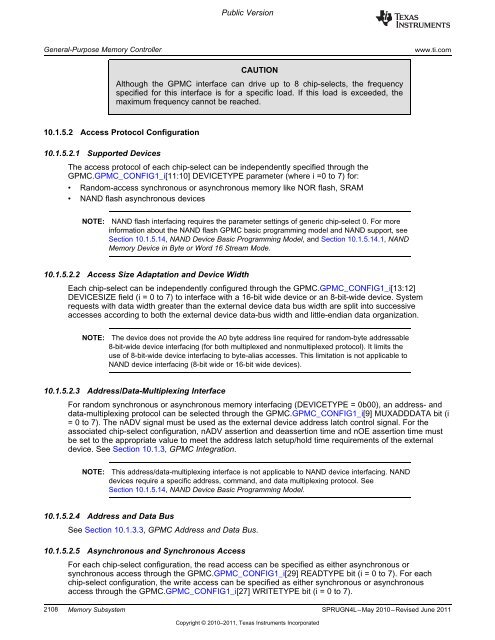Chapter 10 Memory Subsystem.pdf
Chapter 10 Memory Subsystem.pdf
Chapter 10 Memory Subsystem.pdf
Create successful ePaper yourself
Turn your PDF publications into a flip-book with our unique Google optimized e-Paper software.
Public Version<br />
General-Purpose <strong>Memory</strong> Controller www.ti.com<br />
CAUTION<br />
Although the GPMC interface can drive up to 8 chip-selects, the frequency<br />
specified for this interface is for a specific load. If this load is exceeded, the<br />
maximum frequency cannot be reached.<br />
<strong>10</strong>.1.5.2 Access Protocol Configuration<br />
<strong>10</strong>.1.5.2.1 Supported Devices<br />
The access protocol of each chip-select can be independently specified through the<br />
GPMC.GPMC_CONFIG1_i[11:<strong>10</strong>] DEVICETYPE parameter (where i =0 to 7) for:<br />
• Random-access synchronous or asynchronous memory like NOR flash, SRAM<br />
• NAND flash asynchronous devices<br />
NOTE: NAND flash interfacing requires the parameter settings of generic chip-select 0. For more<br />
information about the NAND flash GPMC basic programming model and NAND support, see<br />
Section <strong>10</strong>.1.5.14, NAND Device Basic Programming Model, and Section <strong>10</strong>.1.5.14.1, NAND<br />
<strong>Memory</strong> Device in Byte or Word 16 Stream Mode.<br />
<strong>10</strong>.1.5.2.2 Access Size Adaptation and Device Width<br />
Each chip-select can be independently configured through the GPMC.GPMC_CONFIG1_i[13:12]<br />
DEVICESIZE field (i = 0 to 7) to interface with a 16-bit wide device or an 8-bit-wide device. System<br />
requests with data width greater than the external device data bus width are split into successive<br />
accesses according to both the external device data-bus width and little-endian data organization.<br />
NOTE: The device does not provide the A0 byte address line required for random-byte addressable<br />
8-bit-wide device interfacing (for both multiplexed and nonmultiplexed protocol). It limits the<br />
use of 8-bit-wide device interfacing to byte-alias accesses. This limitation is not applicable to<br />
NAND device interfacing (8-bit wide or 16-bit wide devices).<br />
<strong>10</strong>.1.5.2.3 Address/Data-Multiplexing Interface<br />
For random synchronous or asynchronous memory interfacing (DEVICETYPE = 0b00), an address- and<br />
data-multiplexing protocol can be selected through the GPMC.GPMC_CONFIG1_i[9] MUXADDDATA bit (i<br />
= 0 to 7). The nADV signal must be used as the external device address latch control signal. For the<br />
associated chip-select configuration, nADV assertion and deassertion time and nOE assertion time must<br />
be set to the appropriate value to meet the address latch setup/hold time requirements of the external<br />
device. See Section <strong>10</strong>.1.3, GPMC Integration.<br />
NOTE: This address/data-multiplexing interface is not applicable to NAND device interfacing. NAND<br />
devices require a specific address, command, and data multiplexing protocol. See<br />
Section <strong>10</strong>.1.5.14, NAND Device Basic Programming Model.<br />
<strong>10</strong>.1.5.2.4 Address and Data Bus<br />
See Section <strong>10</strong>.1.3.3, GPMC Address and Data Bus.<br />
<strong>10</strong>.1.5.2.5 Asynchronous and Synchronous Access<br />
For each chip-select configuration, the read access can be specified as either asynchronous or<br />
synchronous access through the GPMC.GPMC_CONFIG1_i[29] READTYPE bit (i = 0 to 7). For each<br />
chip-select configuration, the write access can be specified as either synchronous or asynchronous<br />
access through the GPMC.GPMC_CONFIG1_i[27] WRITETYPE bit (i = 0 to 7).<br />
2<strong>10</strong>8 <strong>Memory</strong> <strong>Subsystem</strong> SPRUGN4L–May 20<strong>10</strong>–Revised June 2011<br />
Copyright © 20<strong>10</strong>–2011, Texas Instruments Incorporated

















